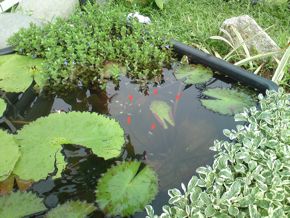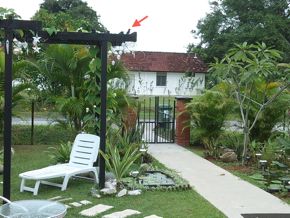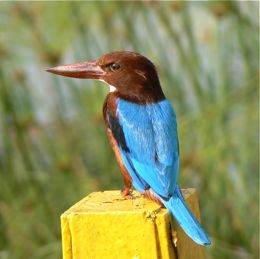“A year ago, there was a discussion thread on this site on the feasibility of attracting kingfishers to gardens. I was then in the process of moving house. In my old house they would regularly raid the colony of sunset platies (Xiphophorus variatus) that lived in the shallower fringes of my koi pond.
“I have attracted wild doves, magpie robins, sparrows and bulbuls (not to mention mynahs) to become frequent visitors in other places where I lived. When I settled into my new (temporary) home, I wondered if it was possible to create a low-cost attraction for kingfishers.
“Well, it was possible. Here are the details.

 [Above shows a close up of milk-and-ink moons on the water surface (left, arrowed in red), and a general view of my garden with a kingfisher (you can barely make it out) perched on the right side of the trellis on which my wife grows flowering creepers (right, arrowed)].
[Above shows a close up of milk-and-ink moons on the water surface (left, arrowed in red), and a general view of my garden with a kingfisher (you can barely make it out) perched on the right side of the trellis on which my wife grows flowering creepers (right, arrowed)].
The containers
“The water containers were plastic garden tubs measuring 120 cm by 60 cm and 45 cm deep (4 feet by 2 feet and 18 inches deep). Tubs like these are readily available in a range of sizes from aquarium shops or garden supplies centres. The size I specify is the minimum necessary to maintain a body of water with a stable temperature and sufficient oxygen in which fish will survive and breed. You can opt for a larger one, but not smaller.
“One container is sufficient to create a regular kingfisher feeding station, but I set up several, some brand new, some recycled after being dug up from my old home. The plastic containers, made of the same material used for making dustbins, are the most economical, at S$110 (US$84) apiece. I had started using such containers for breeding fish and growing aquatic plants more than three years ago. Though I expect them to eventually become brittle and crack, as plastics are wont to do when left outdoors in direct sunlight, none has failed yet.
“If you want a water feature that will last practically forever, then get a fibreglass tub. But, size for size, one made of fibreglass will easily cost at least five times as much as the plastic equivalent.
Placement
“For aesthetic reasons I sank the containers into the ground, with their rims protruding about 5 cm (two inches) above the soil level so as to prevent run-off from rain washing fertilisers and insecticides into the water. The positions I chose were close to trees and trellises that kingfishers could use as lookout perches.
Planting
“If you are lazy, throw some floating plants into the water and add fish a few days later. If you are keen on water gardening, as I am, place a 10 cm (4 inch) layer of substrate into each container. Depending on what you want to plant, you can use either rinsed burnt earth or sand. Burnt earth, available from nurseries is my choice. It may look horrible even when rinsed. But once plants are well-established, the water will clear.
“Suitable plants are Mexican swords (Echinodorus), Water cannas (Thallia dealbata, which also attract sunbirds), Bacopa, and assorted water lilies.
“Water-gardening publications and websites caution against adding compost to the soil in ponds. They are absolutely right. Compost will create a stinking mess. If you feed the fish regularly, they will provide enough fertiliser for most plants except water lilies. If you must fertilise, get products formulated for water gardening from either aquarium shops or nurseries.
“I like lotus, both those that flower and those you can drive. But while those with wheels do draw dolly birds, the ones that grow in water are not right for attracting kingfishers. Lotus grow well in red lateritic clay, a material available almost anywhere you dig beneath the topsoil in this region. But only a few fish species will thrive in water containing such clay, and these are not the fish that tempt kingfishers
Fish
“I have found platies to be best for attracting kingfishers. Platies are hardy. They breed rapidly, and a colony can be self-sustaining despite predation. They are also not very smart. In some of my tubs I have various kinds of gouramis. These very quickly learn to stay out of harm’s way. Soon, kingfishers will think it not worth their trouble to come.
“Platies will continue to swim to the surface despite a few of their number being eaten by kingfishers each day.
“Commercially-produced aquarium platies (also known as Moonfish) are hybrids between various Xiphophorus species. My containers for attracting kingfishers are stocked with a breed known as the Milk and Ink Moon, which probably features Xiphophorus maculatus in its bloodline. In aquaria, Xiphophorus maculatus is more hardy and prolific than Xiphophorus variatus. The Milk and Ink colour variety, being predominantly white, with a few irregular black blotches, is highly visible, an irresistable magnet for kingfishers.
“In Singapore aquarium shops, the runts and rejects of the ornamental fish trade are sold for feeding carnivorous fish. The going rate is about S$2 for each bag of 30 fish. I picked out five Milk and Ink Moons from such a bag. Those were the ancestors of the dozens that now inhabit my tubs and feed the kingfishers.
“Caution: do not mix different colour varieties of platies. If you do, within two or three generations, all will revert to the brown or grey wild colour patterns. You will then have difficulty seeing them, and so will the kingfishers, who will stop coming.
“Why did I not use guppies or Gambusia? I have both in my aquaria. Fancy guppies are actually quite delicate, and will not breed under the conditions I described. Wild guppies, which can survive such conditions, are now rare, both in the trade, and, probably due to the Singapore government’s vigorous anti-mosquito campaigns in which insecticide is liberally used, also rare in drains.
“If you want wild guppies, you probably will have to catch some yourself. These, and Gambusia, are also difficult to see. They are not strong kingfisher magnets.
Maintenance
“It is possible to leave a tub with practically no maintenance for months on end. But as dissolved pollutants build up, breeding will stop. The fish population will decline to quite a low level, and the plants will not do well. Some maintenance is needed to keep the fish happy and breeding, and the plants looking lush and flowering.
“Apart from feeding the fish daily, maintenance is really simple. Once a week I run the garden hose into each tub and allow between a third to half of the water to overflow. Many water plants like still conditions, so a pump that circulates water is not desirable. But they do not like stagnant and stale water, which is why the fresh addition is necessary.
“Once a month I siphon muck from the bottom. And of course I prune the plants. Besides trimming away dead leaves, make sure that at least a quarter of the surface is clear, so that the fish are visible. That is all.
The visitors’ list
“The tubs were set up for the benefit of kingfishers, but even small water bodies attract quite a bit of wild life.
“Almost every day I will see kingfishers, most of the time the White-throated (Halcyon smyrnensis) (above left). Once in a long while the Collared Kingfisher (Halcyon chloris) will drop by (above right).
“Kingfishers are not social, and rather territorial. They usually arrive individually. If more than one comes, they perch some distance apart. They are also skittish, and, unlike some other wild birds, which after a while will get used to observers, kingfishers do not allow humans to approach closely.
“Apart from mynahs, doves and bulbuls coming regularly to drink, the tubs have also encouraged a pair of White Breasted Waterhens (Amaurornis phoenicurus) to take up permanent residency. The waterhens pick up scraps of left-over fish food and forage for snails among the water plants. They also nibble on some of the ornamental plants, notably the young lotus seed pods and sometimes on the buds. I forgive them.
“In my previous house there were visits to my koi pond from the Little Heron (Buteroides striatus) and once, an egret. But so far, none have shown up here. Perhaps these species need to see larger bodies of water before they will come.
“The tubs attract a myriad of dragonflies and the plants around them are home to field frogs and tree frogs, whose chirpy calls can be quite musical. Their tadpoles are an added food source for the birds. However, the common toad (Bufo melanostictus) is unwelcome due to its persistent and irritating croak.
“Nothing, apart from monitor lizards, eat toads or their tadpoles. So far, no monitor lizard has moved in yet. All gate crashing toads that I catch are taken on car rides to a pond far away.”
Lee Chiu San
Singapore
5th March 2011
Images of garden by Lee Chiu San; White-throated Kingfisher by R Subaraj; and Collared Kingfisher by Francis Yap.











2 Responses
Interesting attempt…… around my house, White-throated is always gonna be the default one, also a rare case where a Black-backed probably took shelter of the rain during migration and landed shortly for 1 evening in the storm drain opposite my house. Other kingfishers like the Stork-billed (needs bigger water body much further away from my house) and Black-capped (seen by some birder away from my house once, but the pond that it was known to visit is now seriously contaminated by rubbish disposal). Sewage pond near my house seemed to be a reasonable magnet for waterbirds, but again only the default White-throated comes here, but good news is that the egrets, pond herons, little herons would love to visit, also seen night herons coming in before, in the past a pair of Common Moorhen probably attempt to breed here but that tiny population had died out for years now. Common Sandpiper also gets attracted to such ponds. White-breasted Waterhen of course would not miss it.